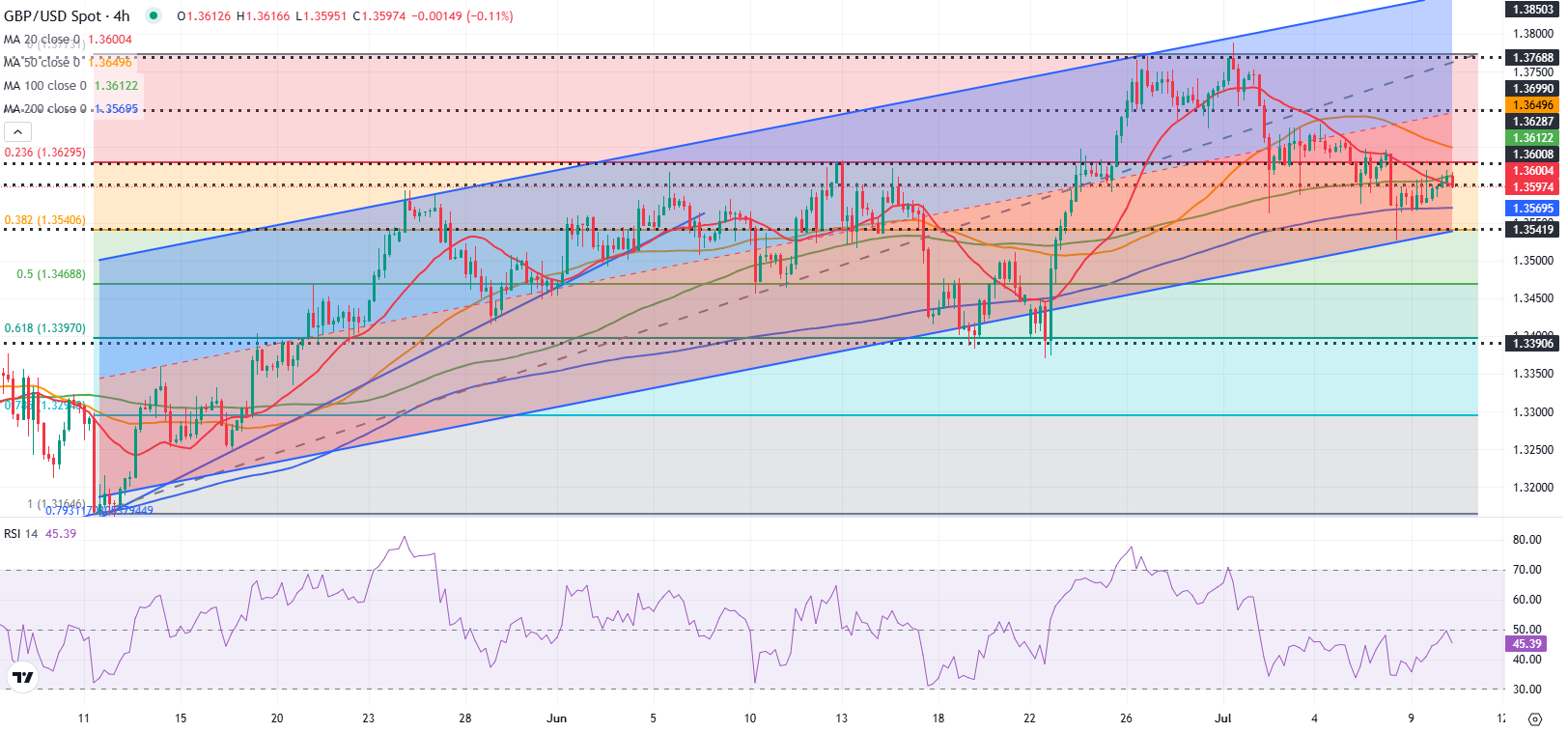
- GBP/USD continues to move sideways near 1.3600 in the European session on Thursday.
- Markets turn cautious while assessing the US trade policy.
- The technical outlook suggests that bearish bias remains intact but lacks momentum.
Following Wednesday’s indecisive action, GBP/USD stays relatively quiet in the European session on Thursday and continues to fluctuate at around 1.3600. Pound Sterling could have a hard time attracting buyers unless the risk mood improves in a noticeable way.
British Pound PRICE This week
The table below shows the percentage change of British Pound (GBP) against listed major currencies this week. British Pound was the weakest against the Australian Dollar.
| USD | EUR | GBP | JPY | CAD | AUD | NZD | CHF | |
|---|---|---|---|---|---|---|---|---|
| USD | 0.47% | 0.42% | 1.37% | 0.58% | -0.08% | 0.61% | 0.14% | |
| EUR | -0.47% | -0.04% | 0.65% | 0.08% | -0.49% | 0.15% | -0.34% | |
| GBP | -0.42% | 0.04% | 0.68% | 0.15% | -0.44% | 0.20% | -0.42% | |
| JPY | -1.37% | -0.65% | -0.68% | -0.55% | -1.22% | -0.52% | -1.16% | |
| CAD | -0.58% | -0.08% | -0.15% | 0.55% | -0.63% | 0.06% | -0.57% | |
| AUD | 0.08% | 0.49% | 0.44% | 1.22% | 0.63% | 0.74% | 0.02% | |
| NZD | -0.61% | -0.15% | -0.20% | 0.52% | -0.06% | -0.74% | -0.62% | |
| CHF | -0.14% | 0.34% | 0.42% | 1.16% | 0.57% | -0.02% | 0.62% |
The heat map shows percentage changes of major currencies against each other. The base currency is picked from the left column, while the quote currency is picked from the top row. For example, if you pick the British Pound from the left column and move along the horizontal line to the US Dollar, the percentage change displayed in the box will represent GBP (base)/USD (quote).
US President Donald Trump reiterated his threat of imposing an additional 10% tariff on any country that aligns with the BRICS group on Wednesday. Trump also shared a new set of tariff letters, unveiling rates on imports from some minor trading partners, such as Libya, Algeria and Philippines.
Investors remain cautious and stay away from risk-sensitive assets as they struggle to assess the US economic and inflation outlook, given the lack of clarity on the US’ trade relations with major trading partners. After Wall Street’s main indexes registered moderate gains midweek, US stock index futures stay in negative territory on Thursday. A bearish action in major equity indexes in the US could allow the US Dollar (USD) to benefit from safe-haven flows and weigh on GBP/USD.
The US economic calendar will feature the weekly Initial Jobless Claims data, which is forecast to show that there were 235,000 first-time applications for unemployment benefits in the week ending July 5. The market reaction to this data is likely to be straightforward and remain short-lived. A noticeable decline could help the USD hold its ground, while a significant increase could hurt the currency.
GBP/USD Technical Analysis

The Relative Strength Index (RSI) indicator on the 4-hour chart stays below 50 after recovering from below-40 earlier in the week, suggesting that the bearish bias remains intact in the short term but lacks momentum.
The 100-period Simple Moving Average (SMA) on the 4-hour chart stays as a pivot level at 1.3600. In case GBP/USD stays below this level and confirms it as resistance, 1.3570 (200-period SMA) could be seen as the next support level before 1.3540 (lower limit of the ascending channel, Fibonacci 38.2% retracement of the latest uptrend) and 1.3500 (static level, round level).
Looking north, resistance levels could be seen at 1.3630 (Fibonacci 23.6% retracement), 1.3650 (50-period SMA) and 1.3700 (mid-point of the ascending channel).
Pound Sterling FAQs
The Pound Sterling (GBP) is the oldest currency in the world (886 AD) and the official currency of the United Kingdom. It is the fourth most traded unit for foreign exchange (FX) in the world, accounting for 12% of all transactions, averaging $630 billion a day, according to 2022 data. Its key trading pairs are GBP/USD, also known as ‘Cable’, which accounts for 11% of FX, GBP/JPY, or the ‘Dragon’ as it is known by traders (3%), and EUR/GBP (2%). The Pound Sterling is issued by the Bank of England (BoE).
The single most important factor influencing the value of the Pound Sterling is monetary policy decided by the Bank of England. The BoE bases its decisions on whether it has achieved its primary goal of “price stability” – a steady inflation rate of around 2%. Its primary tool for achieving this is the adjustment of interest rates. When inflation is too high, the BoE will try to rein it in by raising interest rates, making it more expensive for people and businesses to access credit. This is generally positive for GBP, as higher interest rates make the UK a more attractive place for global investors to park their money. When inflation falls too low it is a sign economic growth is slowing. In this scenario, the BoE will consider lowering interest rates to cheapen credit so businesses will borrow more to invest in growth-generating projects.
Data releases gauge the health of the economy and can impact the value of the Pound Sterling. Indicators such as GDP, Manufacturing and Services PMIs, and employment can all influence the direction of the GBP. A strong economy is good for Sterling. Not only does it attract more foreign investment but it may encourage the BoE to put up interest rates, which will directly strengthen GBP. Otherwise, if economic data is weak, the Pound Sterling is likely to fall.
Another significant data release for the Pound Sterling is the Trade Balance. This indicator measures the difference between what a country earns from its exports and what it spends on imports over a given period. If a country produces highly sought-after exports, its currency will benefit purely from the extra demand created from foreign buyers seeking to purchase these goods. Therefore, a positive net Trade Balance strengthens a currency and vice versa for a negative balance.
Information on these pages contains forward-looking statements that involve risks and uncertainties. Markets and instruments profiled on this page are for informational purposes only and should not in any way come across as a recommendation to buy or sell in these assets. You should do your own thorough research before making any investment decisions. FXStreet does not in any way guarantee that this information is free from mistakes, errors, or material misstatements. It also does not guarantee that this information is of a timely nature. Investing in Open Markets involves a great deal of risk, including the loss of all or a portion of your investment, as well as emotional distress. All risks, losses and costs associated with investing, including total loss of principal, are your responsibility. The views and opinions expressed in this article are those of the authors and do not necessarily reflect the official policy or position of FXStreet nor its advertisers. The author will not be held responsible for information that is found at the end of links posted on this page.
If not otherwise explicitly mentioned in the body of the article, at the time of writing, the author has no position in any stock mentioned in this article and no business relationship with any company mentioned. The author has not received compensation for writing this article, other than from FXStreet.
FXStreet and the author do not provide personalized recommendations. The author makes no representations as to the accuracy, completeness, or suitability of this information. FXStreet and the author will not be liable for any errors, omissions or any losses, injuries or damages arising from this information and its display or use. Errors and omissions excepted.
The author and FXStreet are not registered investment advisors and nothing in this article is intended to be investment advice.








